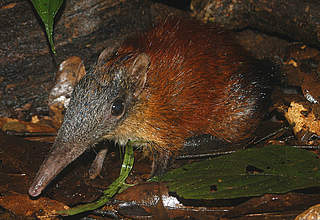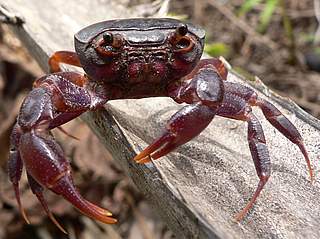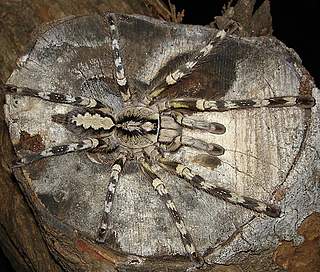According to the International Union for the Conservation of Nature’s (IUCN) 2008 report, released yesterday, 36 percent of the total species evaluated by the organization are threatened with extinction. If one adds the species classified as Near Threatened, the percentage jumps to 44 percent—nearly half.
“It’s time to recognize that nature is the largest company on Earth working for the benefit of 100 percent of humankind – and it’s doing it for free. Governments should put as much effort, if not more, into saving nature as they do into saving economic and financial sectors,” says Jean-Christophe Vié, Deputy Head of IUCN’s Species Programme and senior editor of the publication.
  top: Grey-faced Sengi (Rhynchocyon udzungwensis). Classified as Vulnerable. Photo by: F. Rovero, Trento Museum of Natural Sciences, Italy. Bottom: Purple Marsh Crab (Afrithelphusa monodosa). Classified as Endangered. Photo by: Neil Cumberlidge. |
The report comes just two months before 2010: the target year for the world’s nations to have reduced global biodiversity loss according to the Convention on Biological Diversity. The goal has been signed on by 192 countries, making it nearly unanimous.
“The scientific evidence of a serious extinction crisis is mounting,” says Jane Smart, Director of IUCN’s Biodiversity Conservation Group. “The latest analysis of the IUCN Red List shows the 2010 target to reduce biodiversity loss will not be met. It’s time for Governments to start getting serious about saving species and make sure it’s high on their agendas for next year, as we’re rapidly running out of time.”
The extinction crisis appears to be striking at every taxa. According to IUCN’s latest report 37 percent of freshwater fish, 35 percent of invertebrates, 30 percent of amphibians, 27 percent of coral reefs, 28 percent of reptiles, and 12 percent of birds are currently threatened with extinction. Seven species this year improved from last, while more than double that—seventeen—fell, including three that are now considered extinct in the wild, and one—the Polynesian tree snail—that has vanished altogether.
“This year’s IUCN Red List makes for sobering reading,” says Craig Hilton-Taylor, Manager of the IUCN Red List Unit. “These results are just the tip of the iceberg. We have only managed to assess 47,663 species so far; there are many more millions out there which could be under serious threat.”
Currently the IUCN has evaluated 2.7 percent of the world’s 1.8 million described species. Even more daunting is the fact that no one knows how many species there are: estimates range from a few million to upwards of 20 million.
  Top: Rameshwaram Parachute Spider (Poecilotheria hanumavilasumica). Classified as Critically Endangered. Photo by: M. Siliwal. Bottom: Fishing cat (Prionailurus viverrinus). Classified as Endangered. Photo by: Mathieu Ourioux. |
Global threats to species include climate change; deforestation, as well as other types of habitat loss; poaching and hunting; overfishing; pollution; mining; and development projects like dams.
“The IUCN Red List provides a window on many of the major global issues of our day, including climate change, loss of freshwater ecosystems and over-fishing,” says Simon Stuart, Chair of the IUCN Species Survival Commission and co-editor. “Unless we address the fundamental causes of unsustainability on our planet, the lofty of goals of governments to reduce extinction rates will count for nothing.”
Vie asks the public to imagine a world without biodiversity.
“Think of fisheries without fishes, logging without trees, tourism without coral reefs or other wildlife, crops without pollinators. Imagine the damage to our economies and societies if they were lost. All the plants and animals that make up Earth’s amazing wildlife have a specific role and contribute to essentials like food, medicine, oxygen, pure water, crop pollination, carbon storage and soil fertilization. Economies are utterly dependent on species diversity. We need them all, in large numbers. We quite literally cannot afford to lose them.”
Related articles
Freshwater species worse off than land or marine
(10/15/2009) Scientists have announced that freshwater species are likely the most threatened on earth. Extinction rates for freshwater inhabitants are currently four to six times the rates for terrestrial and marine species. Yet, these figures have not lead to action on the ground.
Alleviating poverty and saving biodiversity are inherently linked argue scientists

(09/17/2009) Twenty-nine scientists argue in Science today that the world will not be able to lift up the world’s poor unless it also addresses global biodiversity loss. They say that the same underlying problems—exploitation of resources, unsustainable overconsumption, climate change, population growth—are exacerbating global poverty and the extinction of species.
Discovering nature’s wonder in order to save it, an interview with Jaboury Ghazoul

(09/08/2009) Sometimes we lose sight of the forest by staring at the trees. When this happens we need something jarring and eloquent to pull us back to view the big picture again. This is what tropical ecologist Jaboury Ghazoul provided during a talk at the Association of Tropical Biology and Conservation (ATBC) meeting this summer in Marburg, Germany. Throwing out a dazzling array of big ideas and even bigger questions—incorporating natural history, biodiversity, morality, philosophy, and art—the enthusiastic Ghazoul left his audience in a state of wonder.